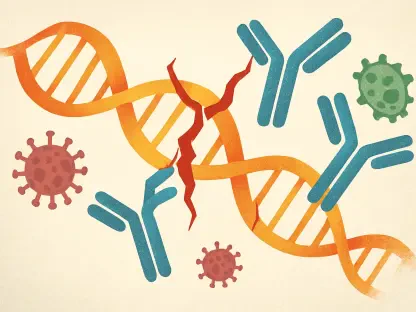The transformative potential of Artificial Intelligence (AI) in the field of therapeutics, particularly drug development, has been a topic of significant excitement and investment. However, despite the enthusiasm, tangible evidence of AI’s success in revolutionizing drug development remains limited. This article delves into the complexities and challenges that AI faces in this domain, questioning whether the narrative surrounding AI’s role has been overly hyped or if there are underlying issues that need to be addressed.
The Drug Development Process: An Overview
The Lengthy and Costly Journey
The process of developing new therapeutics is notoriously slow and expensive. Timelines often extend beyond a decade, and costs can exceed $2 billion, especially for immunotherapy drugs. The probability of success for new drug candidates is alarmingly low, with only about a 5% success rate in immune-oncology and similarly grim statistics across other therapeutic areas. This trend of declining returns on investment in drug development is encapsulated by “Eroom’s law,” a play on Moore’s law, highlighting the increasing difficulty and declining efficiency in drug development despite technological advancements.
The arduous journey from drug discovery to market approval is paved with numerous obstacles. From the initial stages of identifying potential therapeutic targets to conducting preclinical tests and navigating the complexities of clinical trials, each phase is fraught with challenges that can derail progress. Despite the advent of AI and its potential to streamline this process, the inherent complexity of biological systems and the stringent requirements for regulatory approval make it difficult to expedite drug development timelines significantly. As a result, the cost and risk associated with bringing new drugs to market remain high, necessitating a careful balance between innovation and practicality.
Discovery vs. Development: A Focus Imbalance
Most AI-platform companies focus predominantly on the discovery phase of therapeutics, which involves identifying new drug targets or engineering novel therapeutic modalities. This phase is celebrated within the scientific community for its groundbreaking potential and frequent media coverage. In contrast, therapeutic development, viewed as less glamorous, involves rigorous operational processes, stringent scrutiny, and regulatory compliance, making it a less attractive area for AI companies. This phase extends from preclinical testing to clinical trials and eventually to FDA approval.
The allure of the discovery phase lies in its promise of innovation and the potential to uncover novel therapeutic targets that could revolutionize the treatment landscape. However, the transition from discovery to development is where many AI efforts falter. The development phase requires meticulous attention to detail, adherence to regulatory standards, and robust validation of preclinical findings in human trials. AI companies often shy away from this phase due to its perceived lack of glamour and the significant investment required. Consequently, the imbalance in focus between discovery and development hinders the full realization of AI’s potential in transforming drug development.
AI’s Contributions and Limitations
AlphaFold’s Breakthrough in Chemistry
One of the most significant contributions of AI to drug discovery has been DeepMind’s AlphaFold, which has substantially advanced our understanding of protein folding and various molecular interactions in 3D space. This breakthrough in chemistry underpins potential advancements in therapeutic discoveries, particularly for small molecules. However, while AlphaFold’s contribution is notable, the article highlights that biology, particularly systems biology, remains a far more complex field. Understanding interactions at a cellular level, which involves trillions of cells and dynamic biological systems, is exponentially complicated compared to static biochemical interactions. AI’s ability to revolutionize this space is constrained by these inherent complexities.
AlphaFold’s success in predicting protein structures with remarkable accuracy has opened new avenues for drug discovery, particularly in the realm of small molecule therapeutics. By providing detailed insights into protein folding and interactions, AlphaFold has enabled researchers to design more effective drugs that can target specific molecular structures. However, translating these findings into practical therapeutic solutions requires a deep understanding of the intricate biological processes that govern cellular behavior. The complexity of systems biology poses a significant challenge for AI, as it involves dynamic interactions between numerous components that are not easily modeled or predicted. Thus, while AlphaFold represents a significant step forward, the broader application of AI in drug development requires overcoming these complexities.
The Challenge of Translating Preclinical Data
A critical issue in the drug development process is the reliance on preclinical data derived from animal models, like mice, and lab experiments with human tissues. Although drugs often succeed in preclinical tests, they fail to replicate these results in human trials, indicating a significant gap and a lack of predictive power when transitioning from preclinical to clinical stages. This misalignment raises questions about the validity and usefulness of preclinical data, which forms the basis for decisions that shape the biotech industry and impact patient outcomes globally.
Preclinical models are indispensable in the initial stages of drug development for assessing a drug’s safety and efficacy before moving to human trials. However, the physiological differences between animal models and humans often result in discrepancies between preclinical and clinical outcomes. AI’s potential to enhance preclinical testing by integrating various data types and simulating human biological responses holds promise, yet achieving accurate predictive capabilities remains a formidable challenge. Enhancing the translation of preclinical data to successful clinical outcomes necessitates a more nuanced approach to modeling human biology, bridging the gap between animal studies and human trials for better predictive accuracy and ultimately more successful therapeutics.
Building a Robust Data Foundation
The Need for Comprehensive Data
For AI to significantly improve the drug development process, it needs a robust data foundation. This involves extensive sequencing of clinical samples from diverse patient populations and generating vast amounts of experimental data across various models and conditions. Harmonizing preclinical and clinical datasets can bridge gaps and enhance AI’s ability to predict clinical outcomes accurately. Some companies are attempting to map the entire immune system and build predictive AI models to optimize clinical developments. This effort aims to understand why different patients respond differently to drugs, factoring in the complexity and heterogeneity of human immune systems.
Building a comprehensive data foundation for AI in drug development is a multifaceted endeavor that requires collaboration across disciplines and extensive data collection efforts. High-resolution, multi-omics sequencing technologies can capture detailed cellular information, providing a rich dataset for AI algorithms to analyze and interpret. By integrating data from various sources, including genomic, proteomic, and metabolomic profiles, researchers can develop more accurate models of disease and treatment responses. Such comprehensive datasets enable AI to identify patterns and correlations that may not be discernible through traditional analysis methods, ultimately improving the predictive power and effectiveness of AI-driven drug development.
Investment and Long-Term Commitment
Addressing the significant challenges posed by drug development requires substantial investment and long-term commitment, often beyond the typical investment timeframes expected by stakeholders. Building high-resolution, multi-omics sequencing technologies is essential for capturing comprehensive cellular information that AI can utilize effectively. For AI to overcome the constraints of Eroom’s law, biotech companies must prioritize genuine development over fast-tracking specific assets into clinical trials. True advancements in AI-assisted drug development come from thorough and innovative approaches that allow deeper insights into biological systems.
Investing in the future of AI-driven drug development necessitates a paradigm shift in how resources are allocated and how success is measured. Short-term gains and rapid advancements are appealing, but sustainable progress in this field requires a long-term vision and commitment to rigorous scientific inquiry. By prioritizing comprehensive data collection and in-depth analysis, biotech companies can build a robust foundation for AI applications that can withstand the complexities of biological systems and regulatory scrutiny. This approach not only enhances the likelihood of successful drug development but also fosters a more thorough understanding of human biology, paving the way for more personalized and effective therapeutics.
Overcoming Eroom’s Law
Prioritizing Genuine Development
To break free from the constraints of Eroom’s law, biotech companies must prioritize genuine development over fast-tracking specific assets into clinical trials. This involves a commitment to thorough and innovative approaches that allow deeper insights into biological systems. By focusing on building a robust data foundation and understanding the complexities of biological interactions, AI can make more accurate predictions and improve success rates in clinical trials.
Genuine development in the context of AI-driven drug development involves a holistic approach that integrates various scientific disciplines and technological advancements. By leveraging the power of AI to analyze vast datasets and identify novel therapeutic targets, researchers can gain deeper insights into disease mechanisms and treatment responses. This comprehensive approach requires a commitment to rigorous validation processes and adherence to regulatory standards, ensuring that AI-driven discoveries are not only innovative but also safe and effective. By prioritizing genuine development, biotech companies can overcome the inefficiencies highlighted by Eroom’s law and pave the way for more successful and impactful therapeutic advancements.
The Path Forward
The transformative potential of Artificial Intelligence (AI) in therapeutics, especially in drug development, has garnered significant excitement and substantial investment. Yet, despite the enthusiasm, concrete evidence of AI’s substantial impact on revolutionizing drug development is still limited. This prompts a closer look into the complexities and challenges AI encounters in this field. While AI holds promise, its application in drug development faces numerous hurdles, from data quality issues to regulatory barriers and the intricate nature of biological systems. The narrative around AI’s transformative role may be overly optimistic, leading us to question whether the expectations from AI in therapeutic advancements are realistic or if they might be exaggerated. It is essential to scrutinize both the technological limitations and the practical obstacles that hinder AI’s full potential in this domain. Only by addressing these challenges can we truly understand and harness AI’s capabilities to innovate in drug development, ensuring that the investments and hopes placed in this technology are well-founded.









